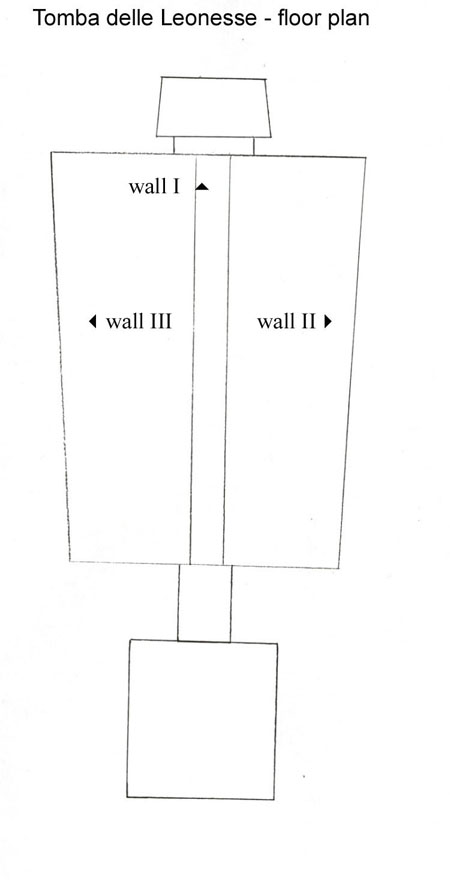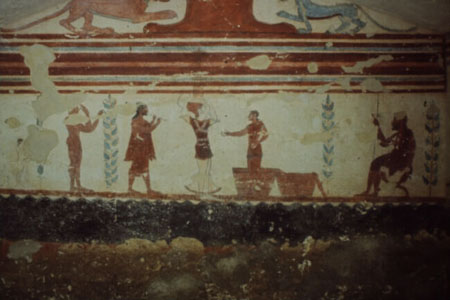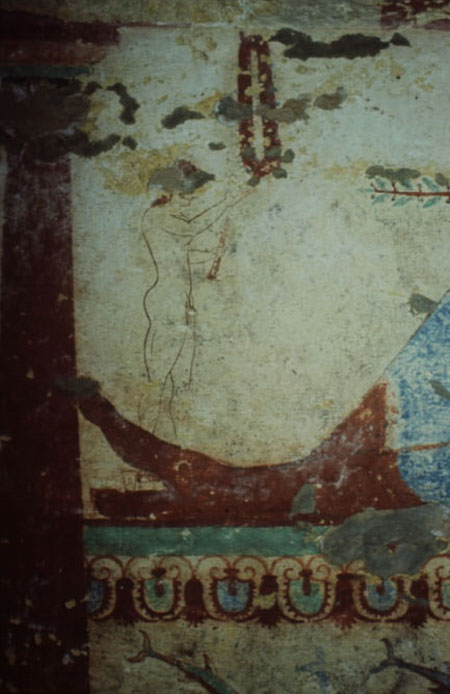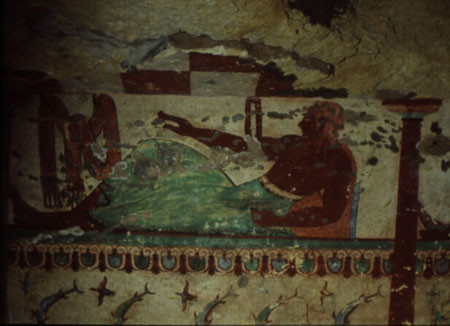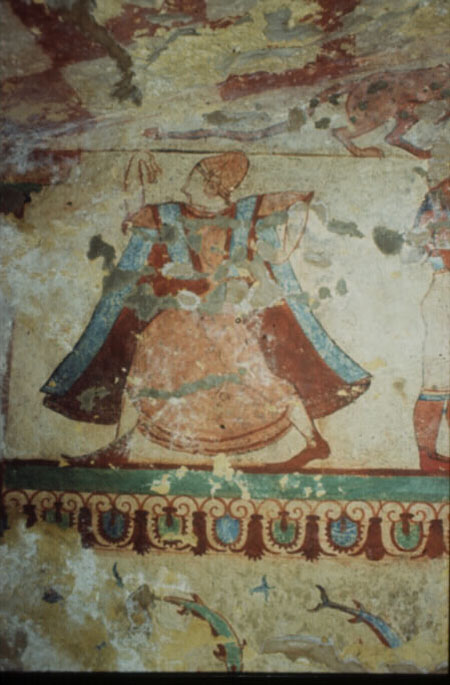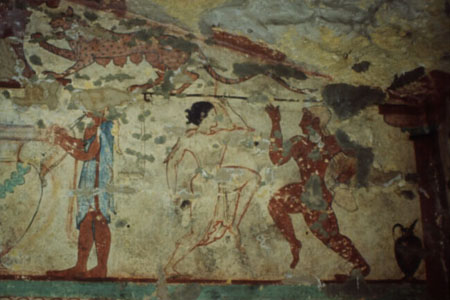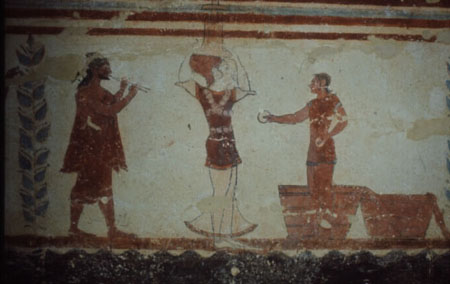Native Publications
by Sonia Amaral Rohter
The Tomba delle Leonesse and the Tomba dei Giocolieri contain some of the best examples of Ionian-influenced tomb painting of the Archaic period in Tarquinia.1 There is a further link between these tombs, and one which sets them apart from every one of the more than twenty-seven painted tombs of this period known from Tarquinia.3 Both tombs have tiny outline figures placed almost incongruously among the scenes of the decoration, two in the Tomb dei Giocolieri and one in the Tomba delle Leonesse. The significance of these miniature intrusions into the scene of the tomb paintings is a matter of debate.
The Tomba delle Leonesse is divided into two registers (figure 4). The lower register on all three walls displays blue waves with green and blue dolphins jumping in and out and birds flying above. The main register of the rear wall (figure 1, wall I) shows a large crater in the center with a man playing the lyre and a dancing woman to the left, and a double-pipe player and a dancing couple to the right. Above this register is a triangular pediment with two lionesses (figure 2). The main register of both the left and the right walls (figure 1, wall III, II) has two reclining banqueters. On wall III, at the feet of the banqueter closest to the rear wall, we find a small outline figure standing on a base (figure 5).
The Tomba dei Giocolieri also has two registers. The lower register of all three walls is painted as the same dark mass of water capped by regularly curling waves that is found in the Tomba delle Leonesse. The main register of the rear wall (figure 3, wall I) shows a man seated on a stool observing a woman balancing a candelabra on her head while the young man standing beside two opens baskets hands her rings to juggle (figure 4). To her right is a flute player and a nude man holding one hand to his face. There follow the two small enigmatic outline figures. One stands on base holding a wreath, while the other sits on the ground with his left arm outstretched and the palm forward (figure 6).
These three outline figures have elicited comment. The outline figure of the Tomba delle Leonesse (figure 5) was first identified by Ducati as a hermaphrodite, the youthful lover of the reclining figure. Presumably a hermaphrodite could circumvent the painting convention of dark skinned men and light skinned because the hermaphrodite is neither truly male nor truly female and for this reason, could be portrayed as an outline figure. According to this theory, the small scale of the figure is a result of his youth. According to Ducati, the figure stands on a podium of some sort as he presents a ring to his lover or for use in a game, just as the Greeks played kottabos with kylixes and wine lees at their symposia. It is difficult, however, to accept this athletic figure as that of a hermaphrodite.
Ducati’s identification of the object in the outline figure’s hands as a ring is also erroneous. The shape of the object and the manner in which the figure holds it are inconsistent with the object being a ring. It is, in fact, an egg. Numerous examples exist in Etruscan tomb painting of figures holding eggs. One of the reclining figures on the opposite wall of the Tomba delle Leonesse holds and egg out (figure 7), as does a figure in the Tomba dei Leopardi3. The shape of the object is not circular: the portion that remains slopes down in a way that is characteristic of the oval shape of an egg.
Steingräber believes that the outline figure in the Tomba delle Leonesse is a “small naked performer” standing on a footstool 4. Others thinking in this same vein have called the figure a servant standing on a podium 5. I believe that the figure is a statue, and the object he stands on is no podium or footstool. It is a statue base. It does not add enough height to be a footstool or podium, and its decoration is inconsistent with it being a footstool or podium. Low statue bases such as that of the outline figure are relatively common. Many Greek kouroi have low bases. A good example of this is the Aristodikos Boy 6.
Indeed, the resemblance between this outline figure and Greek kouroi is obvious. P. Ducati, while dismissing the possibility that the figure is meant to be a statue, comments on the resemblance between the figure’s stance and that of Greek kouroi 7. The overall proportions of the figure, emphasizing the thickness of the thighs and buttocks, are also reminiscent of Greek kouroi. The figure is meant to represent a statue. In addition to the decoration present on the object that the outline figure stands on, there is an inscription. In previous publications of this tomb no mention has been made of the inscription on the base. Only two letters are visible “A” and “I” visible just below the denticulated pattern at the top of the base. The above cited Aristodikos Boy is a particularly appropriate comparison because he has both a low base and an inscription.
The base of the outline figure has a somewhat peculiar shape. Of the kouroi bases that survive, most are rectangular. However, examples do exist that are shaped differently. G.M.A. Richter cites an example from Delos that is triangular with a ram head, a lion head, and a Gorgon head on the corners 8. Also, the Etruscans did not adhere to the rectangular statue base convention with their kouroi figures. Instead they favored “moulded, altar-like bases” 9. An Etruscan mirror now in Paris shows a statue resting on an altar-like base10. With part of the base covered by the feet of the reclining figure, it is difficult to reconstruct its exact form, but its strange shape supports its identification as a statue base.
The statue base appears to have two little pegs or struts sticking out of the left side. Kouroi were usually carved or cast with their plinths, and the plinths were then placed into the base and secured with molten lead 11. In some cases, for additional security, they were held in place with dowels or tangs, and in examples where the plinth but not the base survive, holes are visible on the plinth for the insertion of rods or pegs 12. I believe this is the case with the outline figure’s base. The peg-like structures jutting out of the base were probably meant to be the pegs that held the statue firmly in its base.
The outline figure representing a statue in the Tomba delle Leonesse is very similar to that of the standing outline figure of the Tomba dei Giocolieri 13. The pose of the figure is identical. The only difference is that the arms are reversed; in the Tomba dei Giocolieri the figure’s left arm is held up instead of the right and he holds a wreath instead of an egg or flute. The other arm is missing, so it is possible that either a flute or an egg was held in the left hand. The curve of the back into the buttocks is essentially identical and even the representation of the musculature of the legs is nearly identical to those of the outline figure of the Tomba delle Leonesse. Once again, the base is too low to be a podium or a footstool. It is clear that this figure is meant to be of a small scale, and this reduced scale has no utilitarian motive; it is used solely to convey the fact that this figure is a statue.
It seems probable that at least one of the painters of the Tomba delle Leonesse went on to paint at least the rear wall of the later Tomba dei Giocolieri. Camporeale calls this painter who worked on both tombs the “Maestro delle Leonesse”14. In the Tomba delle Leonesse, however, he was not alone. On the rear wall, the work of the painter who I shall refer to as the Red Line Painter is evident. This painter’s method of preparation involves sketching in his figures in red (instead of incising his design, which is common in other tombs, particularly for foliage), then adding the color, and then adding a black line over the color, or in some cases a black line and then an additional red line on top of that, presumably for added emphasis. His painting style is characterized by extremely thick, somewhat hesitant lines, and he frequently misjudges the space needed for his figures. Often, when adding his thick red line over the black line, he fails to follow the black line accurately so that the black line remains visible, sometimes completely separated from the red line, instead of being covered by it. This is particularly noticeable in the case of the dancing woman wearing a tutulus (figure 8). Her right arm and the lines of her face show both the black and the red line. The Red Line Painter seems to have difficulty drawing hands.
He also prefers to make the outline of the body visible through the clothing by the addition of a red or black line outlining the form of the body underneath the clothes, particularly the thighs and buttocks (figure 9). He also favors oversize feet wearing pointy shoes, caps on women, bracelets, and round decorated earrings. The pointy shoes, while generally common in Etruscan tomb painting, are not favored by the other painter or painters working on the Tomba delle Leonesse. The Red Line Painter also likes to make the sleeves of his garments point out in a sort of curlicue.
The work of the Red Line Painter appears again on the rear (figure 1 wall I) and right wall (figure 1 wall II) of the Tomba dei Giocolieri. Among the dancing figures on wall II there is evidence of both a red and a black line (figure 10). Red lines are visible on the women’s’ faces, arms, hands and necks. As we have come to expect, the painter had particular trouble with the hands. The outlines of the women’s’ bodies are drawn in a thick line visible through their clothing, though the line is black this time instead of red. Bracelets and round, discus earrings are once again in evidence, as are the pointy shoes, flipped out sleeves, and bell-shaped form of the drapery. On the rear wall, the juggler (figure 11) wears the Red Line Painter’s favorite type of cap for women, the tutulus 15. The juggler also has pointy sleeves, bell-shaped drapery, and disc earrings. The thick but hesitant character of the lines is also present.
The standing and seated outline figures at the Tomba dei Giocolieri are probably also the work of the Red Line Painter. The nose of the seated figure is one of the two nose types that the Red Line Painter prefers. It has a good parallel in the turned up, button nose of the nude standing male (figure 4) to the right of the outline figures. The contours of the two outline figures are also somewhat hesitant, and the thickness of the line is not even, becoming thicker at some points, particularly at the shoulders and at the small of the back. The outline figures adhere to all the expected elements of the Red Line Painter’s technique except for the lack of a visible red line. These two figures appear to have been done without a preparatory sketch, another connection between these figures and the outline figure of the Tomba delle Leonesse.
Though the standing outline figure of the Tomba dei Gioccolieri is similar to the outline figure of the Tomba delle Leonesse, it is unlikely that the Leonesse outline figure is the work of the Red Line Painter. The Leonesse outline figure is the work of the second hand at work in the Tomba delle Leonesse. This painter is very confident in his lines, and is very comfortable working in the Greek-inspired style. This painter was responsible for the outline figure, the dolphins, the birds, the and palmette-lotus-tassel fringe for certain, and perhaps for the crater, the ladle and the two right-most dancing figures (figure 9). The dolphins, tassel-fringe, birds, and outline figure all reveal an assured hand. There is no evidence of the hesitation marks so common with the Red Line Painter. These figures also have considerable detail, another characteristic of the second painter at the Tomba delle Leonesse. It is also possible that the second painter made the second outline of the crater (figure 2). The first outline of the crater, done in a thick red line (presumably the work of the Red Line Painter) was replaced in part by a much smoother black line. The ladle may also be the work of the second painter.
The presence of at least two hands in the painting of the tomb is also indicated by the presence of two different types of column capitals in the decoration. One type, found to the left of the dancing figure with a tutulus, has a bird-head profile (the green curlicue section has been transformed into a bird’s head in profile, complete with an eye), while the other capitals do not. 16
In my opinion the Red Line painter clearly worked on both tomb. Very possibly having seen the outline figures drawn by his associate in the Tomba delle Leonesse he tried his hand at the same thing in the Tomba dei Giocolieri.
But what of the Greek, and one might say even Attic, style of the outline figures, especially the two figures standing on their statue bases? As long ago as 1863 W. Helbig suggested that, “Etruscan artists already had books of models which provided what were effectively collections of Greek compositions for copying.”17 L.V. Borrelli goes on to add that these “……were probably the same collections used by contemporary pottery decorators with whom tomb painters had such close links as to suggest that they frequently exchanged occupations.” 18 In this case, both painters might have been looking to the same drawing for inspiration.
The Tomba delle Leonesse and the Tomba dei Gioccolieri are clearly linked by more than just a similarity in the Ionic style of the figured decoration. The relationship between the two tombs is due to the fact that two artists worked in both. One of these artists, betraying an interest in Attic graphic style, was emulated by the second, so that both left elegant footnotes to their work in the outline figures appearing in the decoration of both tombs. 19
